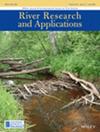通过分布式温度传感器确定山区河流集水区的微流体交换流
IF 1.9
4区 环境科学与生态学
Q4 ENVIRONMENTAL SCIENCES
引用次数: 0
摘要
全球变暖加剧了低流量条件下的溪流温度升高,这种压力会直接或与其他压力共同影响水生物种。溪流温度受空气-水界面能量通量以及水-河床界面水文交换过程的影响。受交换流影响的小尺度溪流温度动态在溪流温度研究中的代表性仍然不足。为了研究沉积物-水界面的高分辨率温度动态和水文交换过程,我们在金齐格山区集水区的两个地点应用了光纤分布式温度传感技术(FO-DTS),并对其他环境条件进行了测绘和测量。在一个地点,在低流量和高气温条件下可以观察到两种类型的温度异常。阻尼效应与水池、植被根系、细小沉积物等河流特征以及河岸渗流迹象相吻合,这表明河水交换流。在沉积物暴露在空气中、河岸植被遮蔽不明显的浅水区,白天底质温度升高。在另一个因沉积物成分而无法埋设电缆的地点,上覆水体的温度异常表明地下水漫流渗出。结果表明,下垫面区的小规模过程、低地下水位和河岸遮蔽对山区溪流的溪流温度有影响,在合适的条件下可以用 FO-DTS 进行识别。这些结果提高了我们对(地下蓄水层)溪流温度的认识,并为如何改进水文模型提供了重要信息。本文章由计算机程序翻译,如有差异,请以英文原文为准。
Hyporheic exchange flows in a mountainous river catchment identified by distributed temperature sensing
Elevated stream temperatures under low‐flows, exacerbated by global warming, are a stressor that affects aquatic species directly or in combination with other stressors. Stream temperatures are influenced by energy fluxes across the air–water interface as well as by hydrological exchange processes occurring at the water–riverbed interface. Small‐scale stream temperature dynamics influenced by exchange flows are still underrepresented in stream temperature research. To investigate high‐resolution temperature dynamics and hydrological exchange processes at the sediment–water interface we applied fiber‐optic distributed temperature sensing (FO‐DTS) at two sites in the mountainous Kinzig catchment combined with mapping and measurement of additional environmental conditions. Two types of temperature anomalies could be observed at one site under conditions of low flow and high air temperature. Dampening effects coincided with riverine features such as pools, vegetation roots, fine sediment, and signs of streambank seepage which indicated hyporheic exchange flows. Increased heating of the substrate during the day was identified in shallow sections where sediment was exposed to the air and shading from riparian vegetation was patchy. At another site, at which the cable could not be buried because of the sediment composition, temperature anomalies in the overlying water indicated diffuse groundwater exfiltration. The results show that small‐scale processes in the hyporheic zone, low water tables, and riparian shading influence stream temperature in mountainous streams and can be identified with FO‐DTS under suitable conditions. The results improve our understanding of stream temperatures (in the hyporheic zone) and provide important information on how to improve hydrological modeling.
求助全文
通过发布文献求助,成功后即可免费获取论文全文。
去求助
来源期刊

River Research and Applications
环境科学-环境科学
CiteScore
4.60
自引率
9.10%
发文量
158
审稿时长
6 months
期刊介绍:
River Research and Applications , previously published as Regulated Rivers: Research and Management (1987-2001), is an international journal dedicated to the promotion of basic and applied scientific research on rivers. The journal publishes original scientific and technical papers on biological, ecological, geomorphological, hydrological, engineering and geographical aspects related to rivers in both the developed and developing world. Papers showing how basic studies and new science can be of use in applied problems associated with river management, regulation and restoration are encouraged as is interdisciplinary research concerned directly or indirectly with river management problems.
 求助内容:
求助内容: 应助结果提醒方式:
应助结果提醒方式:


